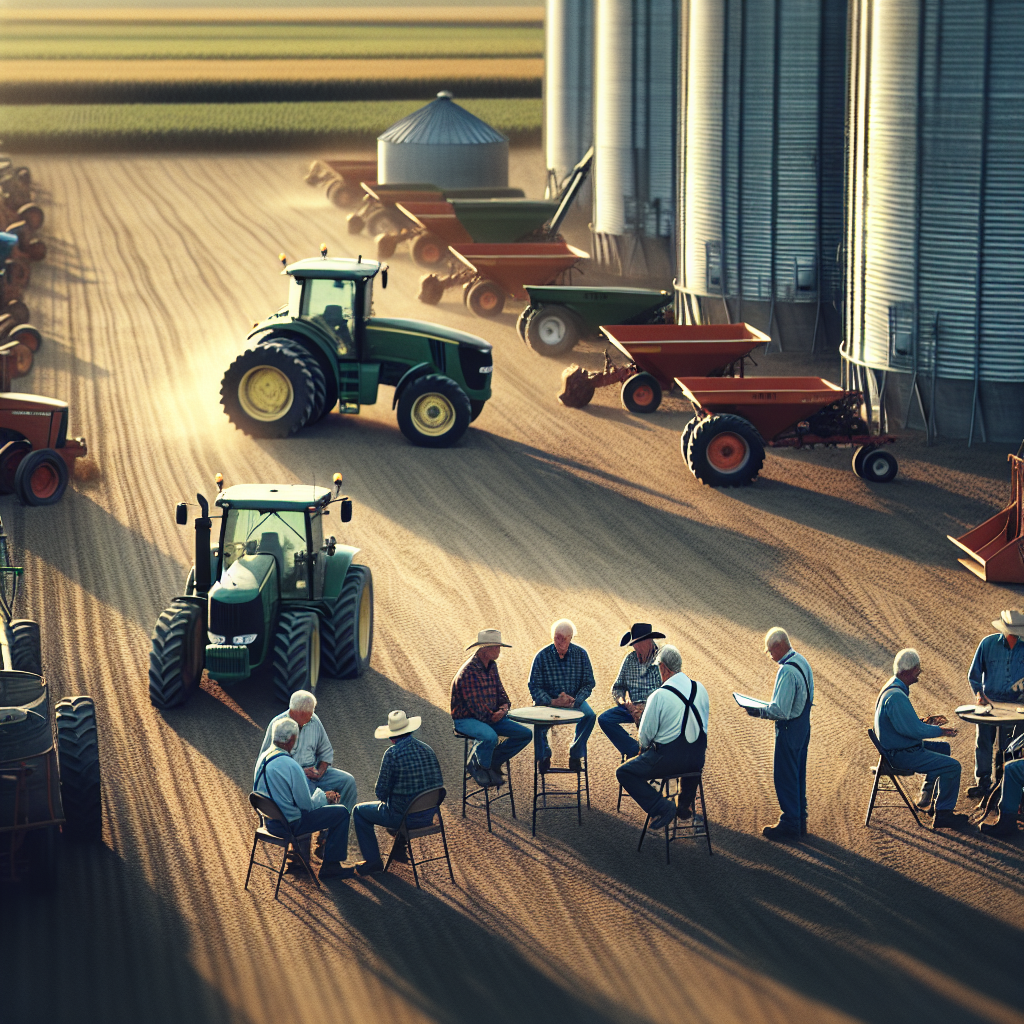Introduction to Networking in Agriculture
Have you ever thought about how farming isn’t a solitary task as it is often portrayed? In reality, the modern farming landscape thrives on robust networking of diverse actors. This blog post explores the world of agricultural networking.
From its significance in sharing knowledge and accessing resources, to how to build a strong agricultural network, this comprehensive guide has got you covered.
Furthermore, it unpacks the role of the internet in farming and explores some pioneering initiatives like the Farmer Business Network and its unparalleled benefits to modern farmers.
The final part of the article imparts practical tips on connecting with local farmers. So, are you ready to explore the interconnected universe of farming? Let’s get started!
What is Networking in Agriculture?
The Importance of Networking in Agriculture
Networking in agriculture refers to the connections and collaborations between farmers, researchers, businesses, and other stakeholders. These interactions help share knowledge, resources, and innovations that can improve productivity and sustainability.
Effective networking can boost a farmer’s access to:
- Latest research and technologies
- Market opportunities
- Funding and financial support
Types of Agricultural Networks
Agricultural networks can vary widely in form and function. Some common types include:
- Farmer Cooperatives: Groups of farmers pool resources to increase buying power and secure better prices for their products.
- Research Networks: Collaboration between researchers and farmers to apply scientific findings to practical scenarios.
- Marketing Networks: Connecting farmers with local, regional, or global markets.
Benefits of Networking in Agriculture
The benefits of networking in agriculture are numerous, including:
| Benefit | Details |
|---|---|
| Information Sharing | Farmers can stay updated on best practices and innovations. |
| Access to Resources | Networking provides contacts for equipment loans, grants, and other resources. |
| Market Access | Helps farmers find new markets and improve sales. |
| Support Systems | Offers emotional and social support, reducing the isolation often felt in farming. |
How to Build a Strong Agricultural Network
Building a robust network involves several steps:
- Join Local Groups: Engage with local farming cooperatives or extension programs.
- Attend Conferences: Participate in agricultural conferences and workshops.
- Leverage Social Media: Use platforms like LinkedIn or Facebook to connect with other professionals.
- Partner with Universities: Collaborate on research projects to gain insights and innovations.
Real-World Examples
One notable example of an agricultural network is Global Farmers Network. This organization connects farmers worldwide to share experiences, knowledge, and resources, thus improving globalization in agriculture.
Another example is local extension programs, often affiliated with universities. These programs provide workshops, resources, and direct support aimed at helping farmers improve productivity.
Learning from successful networks can provide inspiration and direction for building your own connections.
Exploring the Farmer Business Network
Defining the Farmer Business Network
Farmer Business Network (FBN) is an innovative example of networking in the agricultural industry. Launched in 2014, FBN is an independent farmer-to-farmer network that seeks to reimagine the traditional agricultural network structure. It aims to create a more beneficial business environment for farmers by placing power and information directly in their hands.
Services Offered by FBN
FBN provides an array of services designed to meet the needs of modern farmers to drive sustainable growth. These services include:
- FBN Direct: An e-commerce platform that allows farmers to buy a wide range of agricultural inputs at competitive prices.
- FBN Finance: A suite of financial services offerings, including operating loans and equipment financing.
- FBN Crop Marketing: Helping farmers market their crops effectively and increase profitability.
- Data Driven Insights: Leveraging the power of on-farm data to provide actionable insights that help farmers make better decisions.
Benefits of FBN
FBN offers significant benefits to farm business owners, some of which include:
| Benefit | Description |
|---|---|
| Reduced Costs | Direct purchasing helps minimize the cost of inputs and maximize profitability. |
| Increased Market Knowledge | Comprehensive market data help farmers make informed decisions about crop marketing and sales. |
| Financial Flexibility | Financial services provide funding options tailored to each farm’s needs. |
| Actionable Insights | In-depth insights derived from shared data enable better farm management and yield optimization. |
Joining the FBN
Joining FBN simply involves a membership fee and the willingness to share anonymized farm data. Through this data sharing, farmers gain access to a wealth of information and insights generated from other farms and can leverage shared learnings for their own benefit.
Application of FBN’s Model
One of the best examples of FBN’s effectiveness lies in its capacity to offer product price transparency. Using the power of shared data, FBN members can see real-world prices that other farmers across the country have paid for the same inputs. This level of transparency is rare in this industry and offers huge advantages in enabling farmers to negotiate better prices.
FBN’s technology-driven, data-heavy approach provides a modern twist on agricultural networking by empowering farmers with real-time, actionable intelligence that enhances both productivity and profitability. This farmer-centric approach is transforming the way farmers network and conduct business, offering an exciting direction for the future of agriculture.
What Can the Internet Do for Farmers?
Enhanced Market Access
The internet can drastically enhance a farmer’s access to markets. Online platforms and marketplaces allow farmers to connect directly with buyers, cutting out the middleman and potentially increasing their profit margins. Websites like Farmers Market Online and LocalHarvest help farmers sell their products to a wider audience. Additionally, global e-commerce giants like Amazon and Alibaba provide venues for selling agricultural products worldwide.
Access to Real-Time Information
The internet provides farmers with real-time data critical for effective farm management. This includes weather forecasts, pest and disease alerts, and market prices. Websites and apps like Weather.com and AgWeb deliver timely updates that help farmers make informed decisions about planting, irrigating, and harvesting.
Furthermore, precision agriculture technologies rely on internet connectivity for real-time crop monitoring and management. This includes the use of IoT devices to monitor soil moisture, crop health, and more. Platforms such as Climate FieldView collect and analyze data, providing actionable insights to farmers.
Educational Resources and Training
Online learning platforms offer a wealth of educational resources and training for farmers. Websites like Coursera, FutureLearn, and agricultural extension programs like eXtension provide courses on various agricultural topics. These can range from the basics of sustainable farming practices to advanced techniques in biotechnology, allowing farmers to continuously improve their skills and knowledge.
Networking and Community Building
The internet facilitates networking and community building among farmers. Online forums, social media groups, and specialized platforms connect farmers with each other, researchers, and industry experts. These interactions can lead to the sharing of best practices, troubleshooting advice, and emotional support. Platforms like AgTalk and Facebook groups specifically for farmers are prime examples of the internet fostering agricultural communities.
Financial Services and Support
Access to financial services is vital for farm sustainability. The internet provides a platform for farmers to apply for loans, grants, and insurance. Online services like Kiva and AgriLending offer farming-specific financial products designed to meet the unique needs of agricultural enterprises. Additionally, crowd-funding platforms like Kickstarter and GoFundMe enable farmers to pursue innovative projects by gathering small investments from a large number of people.
Supply Chain Management
The internet plays a critical role in modern supply chain management. E-commerce websites, logistics platforms, and supply chain management software help farmers streamline their operations. Platforms like Farmigo and Harvie assist farmers in managing subscriptions, deliveries, and logistics, ensuring that fresh produce reaches consumers in a timely manner.
Technology Adoption
The internet is a valuable resource for discovering and adopting new technologies. Agricultural tech startups often showcase their innovations online, providing farmers with access to the latest advancements. Websites such as TechCrunch’s AgFunder and PrecisionAg list new products and technologies that can improve farm efficiency and productivity.
Overall, the internet offers a multitude of resources and tools that can significantly benefit farmers, from expanding their markets and accessing real-time information to connecting with communities and embracing new technologies. For further reading on how the internet bolsters agricultural practices, check out this [comprehensive article on Precision Agriculture](https://www.agriculture.com/news/technology/precision-agriculture).
How to Connect with Local Farmers
Leverage Farmers’ Markets
One of the easiest ways to connect with local farmers is by visiting farmers’ markets. These markets are not just places to buy fresh produce, but also opportunities to build relationships with local food producers. Engage in conversations with farmers about their farming practices, crops, and challenges they face.
Online Directories and Marketplaces
Utilize online directories and marketplaces designed to connect consumers with local farmers. Websites like LocalHarvest enable you to find nearby farms, CSAs (Community Supported Agriculture), and farmers’ markets. These platforms often include contact information and details about what each farm offers.
Join Community Supported Agriculture (CSA)
Community Supported Agriculture programs allow you to buy a share of a farmer’s harvest in advance. This not only supports the farmer financially but also provides regular, fresh produce to your doorstep. By joining a CSA, you can form a closer relationship with the farmer, learn more about sustainable farming practices, and even get involved in farm activities.
Attend Agricultural Events and Workshops
Participate in local agricultural events, workshops, and farm tours. These gatherings are rich opportunities to meet and network with multiple farmers. Check out local agricultural extension offices or university programs for schedules of upcoming events. Websites such as Eventbrite and local agricultural extension sites often list these types of events.
Use Social Media Platforms
Social media can be a powerful tool for connecting with local farmers. Follow local farm pages on Facebook, Instagram, or Twitter to stay updated on their activities. Many farmers use social media to share their stories, announce events, and sell products directly to consumers. Engage with their posts by liking, sharing, and commenting to build rapport.
Engage with Cooperative Extensions and Local Farming Organizations
Reach out to cooperative extensions and local farming organizations for information and opportunities to connect with farmers. These organizations often provide valuable resources, host events, and facilitate networking among farmers and the community. Examples include the USDA’s Cooperative Extension System and The American Farm Bureau Federation.
Volunteer on a Farm
Volunteering on a local farm is an excellent way to understand the agricultural process and build a strong relationship with local farmers. Many farms welcome volunteers for various tasks like planting, harvesting, and animal care. It’s a hands-on method to learn about farming while contributing to the community.
Utilize Apps and Digital Platforms
There are several apps and digital platforms designed to connect consumers directly with local farmers. Apps like Farmigo and Harvie allow users to subscribe to local farm deliveries, manage order logistics, and gain insights into farm operations. These platforms enhance transparency and foster direct connections between farmers and consumers.
Visit Local Agricultural Fairs
Agricultural fairs are not only fun family events but also opportunities to connect with local farmers and producers. You can learn about local agriculture, taste farm-fresh products, and have direct interactions with farmers. Check your local community calendar for upcoming agricultural fairs.
Collaborate on Community Projects
Join or initiate community projects that focus on local food production and sustainable agriculture. Collaborations on community gardens, urban farms, and educational programs can lead to strong networks with local farmers. Projects like these often require partnerships and provide mutual benefits to everyone involved.
For additional ideas and strategies on connecting with local farmers, check out this insightful [article by Modern Farmer](https://modernfarmer.com/2019/06/8-great-ways-to-connect-with-your-local-farmer/).
Conclusion
Networking in agriculture is a powerful tool that brings together various stakeholders such as farmers, researchers, businesses, and technologists. Not only does it provide countless opportunities for knowledge sharing, resource pooling, and innovation exchange, but it also enhances productivity, profitability, and sustainability of farming practices. Agricultural networking can take several forms, including farmer cooperatives, research networks, and marketing networks. The internet also plays a key role in agricultural networking by offering real-time data, educational resources, access to financial supports, and market expansion opportunities. The practical strategies outlined in the piece, like leveraging farmer’s markets, joining CSAs, attending agricultural events, and utilizing social media, can help individuals to connect with local farmers.
Frequently Asked Questions – FAQs
What is networking in agriculture?
Networking in agriculture involves collaborations and connections among farmers, researchers, businesses, universities, and other entities in the agricultural sector. It facilitates the sharing of knowledge, resources, and innovations for the betterment of agricultural practices.
Why is networking important in agriculture?
Networking plays a significant role in the agriculture sector by opening new research avenues, markets, funding opportunities, and access to the latest technologies. It also fosters a sense of community among farmers, thus reducing the isolation often felt in farming.
What types of agricultural networks are there?
There are several types of agricultural networks such as farmer cooperatives, research networks, and marketing networks. These networks serve different purposes but collectively contribute to the advancement of the agriculture sector.
How can the internet benefit farmers?
The internet is a boon for farmers as it provides real-time data, educational resources, access to financial supports, and market expansion opportunities. It also enhances networking and community-building among farmers and between farmers and consumers.
How can I connect with local farmers?
There are several ways to connect with local farmers, including visiting farmer’s markets, joining CSAs, participating in agricultural events, and utilizing social media. You can also utilize online directories, volunteer on local farms, or engage in community projects focused on local food production.






